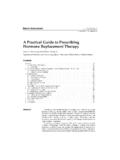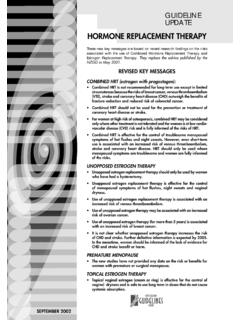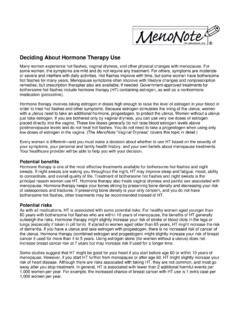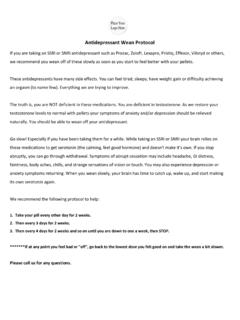Transcription of hormone replacement therapy - European …
1 European Medicines Agency Pre-authorisation Evaluation of Medicines for Human Use 7 Westferry Circus, Canary Wharf, London, E14 4HB, UK Tel. (44-20) 74 18 84 00 Fax (44-20) 74 18 86 13 E-mail: EMEA 2005 Reproduction and/or distribution of this document is authorised for non commercial purposes only provided the EMEA is acknowledged London, 13 October 2005 Doc. Ref. EMEA/CHMP/021/97 Rev. 1 COMMITTEE FOR MEDICINAL PRODUCTS FOR HUMAN USE (CHMP) GUIDELINE ON CLINICAL INVESTIGATION OF MEDICINAL PRODUCTS FOR hormone replacement therapy OF OESTROGEN DEFICIENCY SYMPTOMS IN POSTMENOPAUSAL WOMEN DRAFT AGREED BY THE EFFICACY WORKING PARTY January 2005 ADOPTION BY CHMP FOR RELEASE FOR CONSULTATION January 2005 END OF CONSULTATION (DEADLINE FOR COMMENTS) July 2005 AGREED BY THE EFFICACY WORKING PARTY September 2005 ADOPTION BY CHMP 13 October 2005 DATE FOR COMING INTO EFFECT 1 May 2006 This guideline replaces Points to Consider on Clinical Investigation of Medicinal Products for the Treatment of hormone replacement therapy (CPMP/EWP/021/97).
2 Page 2/11 EMEA 2005 GUIDELINE ON CLINICAL INVESTIGATION OF MEDICINAL PRODUCTS FOR hormone replacement therapy OF OESTROGEN DEFICIENCY SYMPTOMS IN POSTMENOPAUSAL WOMEN TABLE OF CONTENTS EXECUTIVE SUMMARY .. 3 1. INTRODUCTION (BACKGROUND) .. 3 2. 3 3. MAIN GUIDELINE TEXT .. 4 REFERENCES (SCIENTIFIC AND / OR LEGAL) .. 9 Page 3/11 EMEA 2005 EXECUTIVE SUMMARY Guidelines have been developed to provide advice on selected areas relevant to the development of medicinal products in specific therapeutic fields. This document related to hormone replacement therapy (HRT) will be revised in accordance with the scientific advances made in this area. The current version is a revision of the Points to consider document on hormone replacement therapy in postmenopausal women (adopted by CHMP in November 1997) 1.
3 INTRODUCTION (background) hormone replacement therapy (HRT) in postmenopausal women is generally defined as treatment with oestrogen or a combination of oestrogen plus progestogen. The addition of a progestogen to the oestrogen regimen is aimed at preventing the increase in endometrial cancer risk associated with oestrogen therapy in women with uterus. Two indications are currently proposed for most products: - hormone replacement therapy for oestrogen deficiency symptoms in postmenopausal women, prevention of osteoporosis in postmenopausal women at high risk of future fractures who are intolerant of, or contraindicated for, other medicinal products approved for the prevention of osteoporosis. This document only focuses on the first indication.
4 In women with severe oestrogen deficiency symptoms, HRT of any type is effective for symptom relief. However, there is evidence for an increased risk of breast and endometrial cancer that increases with increasing duration of HRT with all types of oestrogens; this risk may be enhanced for breast cancer and is reduced for endometrial cancer when a progestogen of any type is added. Additionally, HRT is associated with an increased risk of venous thromboembolism and stroke. Recent placebo-controlled data contradicted previously published epidemiological studies suggesting benefits of HRT on coronary heart disease. An increased risk of acute myocardial infarction in women taking combined HRT was shown, at least during the first year of use. In view of this risk profile, for the initiation and the continuation of treatment, the minimum effective dose for the shortest duration should be used.
5 And in all cases, a careful appraisal of the risks and benefits should be undertaken at least annually and HRT should only be continued as long as the benefit outweighs the risk (core SmPC for HRT). 2. SCOPE The aim of this position paper is to provide recommendations on specific issues for the development of a medicinal product containing as active substance: an oestrogen alone; an oestrogen in combination with a progestogen; a progestogen to be given with an oestrogen; in the treatment of oestrogen deficiency symptoms in post-menopausal woman. For the time being, there is very limited experience with other hormonal treatments for oestrogen deficiency symptoms in postmenopausal women. Therefore, the development of such kind of products will be out of scope of this document.
6 Page 4/11 EMEA 2005 The population of perimenopausal women is also out of scope of this document. The perimenopausal period is not well defined for regulatory purposes; this transitional period is marked by irregularity of menstrual cycles and of variable climacteric symptoms, for a variable duration of time. In addition, oestrogen therapy is not usually recommended during perimenopause as cyclic endogenous oestrogen production has not yet ceased. Moreover, practices to treat perimenopausal symptoms vary from one country to another and from one physician to another. Therefore, specific guidance on hormone replacement therapy for the population of perimenopausal women can not be given for the time being. 3. MAIN GUIDELINE TEXT A) GENERAL ISSUES The validated standards across EU are largely different from country to country including progestogens added to oestrogen replacement therapy , mode of treatment (continuous or sequential), dose of oestrogen, route of administration (oral, transdermal).
7 Companies are therefore advised to check the validity of their references (see chapter B, Pharmacokinetic studies) before conducting their kinetic and/or clinical development. B) PHARMACOKINETIC STUDIES For all applications, pharmacokinetic data are required as discussed in the CHMP note for guidance 'Pharmacokinetic studies in man'. For abridged applications where bioequivalence with a reference product is claimed, pharmacokinetic data should be provided as follows: for oral medicinal products, the note for guidance on the 'Investigation of bioavailability and bioequivalence' (CPMP/EWP/QWP/1401/98) will apply. for transdermal pharmaceutical forms, bioequivalence should be determined at steady state. Each type of transdermal pharmaceutical form is recommended to be compared with a similar, approved system ( , matrix vs matrix).
8 The following criteria should be fulfilled on the basis of two-sided 90% confidence intervals (CI) for the ratio of means (test/reference). AUC, Cmax : CI lies entirely within the range 80-125% These criteria would ensure that the concentration-time profile of the test falls within the concentration range of the reference. Bioequivalence data are not needed for all strengths provided that the applicant demonstrates dose-proportionality for the test within the applied dose-range. The daily dose stated for a transdermal system should be based on pharmacokinetic bioequivalence data. Hence, correction for 'amount released from patch' is not accepted. C) CLINICAL STUDIES 1. Efficacy Treatment of symptoms related to oestrogen deficiency The term climacteric symptoms is frequently used for symptoms occurring in women before the actual menopause.
9 However, this term may be inaccurate, since not all those symptoms are in fact caused by low oestrogen. Therefore, the most suitable expression is oestrogen deficiency symptoms . The most important oestrogen deficiency symptoms are vasomotor symptoms (hot flushes). The severity of hot flushes is defined clinically as follows: - mild: sensation of heat without sweating - moderate: sensation of heat with sweating, able to continue activity - severe: sensation of heat with sweating, causing cessation of activity Page 5/11 EMEA 2005 Only moderate to severe and severe hot flushes are to be treated by HRT. The proposed primary endpoint for efficacy trials is the frequency of moderate to severe hot flushes. Enrolled subjects should have a defined minimum of hot flushes per day at baseline to justify a need for treatment (at least 5 moderate to severe hot flushes).
10 The Kupperman index could be accepted as a secondary endpoint to assess efficacy. Other scales, if fully validated, can also be used. Placebo-controlled studies are considered sufficient to demonstrate efficacy of an oestrogenic product. A duration of treatment of 3 months is generally recommended for symptom efficacy evaluation. 2. Safety Endometrial safety For a new combination of oestrogen/progestogen ( new administration scheme or new strength) or a new progestogen in a fixed combination, endometrial data are required. For a new medicinal product containing as active substance an oestrogen which would show an increase in bioavailability compared to a reference product (on the basis of pharmacokinetic data), endometrial safety data are required.
















